|
Heart disease is the number one cause of
death in the western world. The heart is a very electrically
dynamic organ. Heart disease includes many causes. These
range from vascular disease, electrical conduction defects,
muscle problems, valvular effects, congenital defects,
infectious problems, trauma and pericardial problems, etc.
Other non-direct problems can also affect the heart secondary
to other systemic issues, including, but not limited to,
hypertension, kidney disease, lung disease, autoimmune
diseases, toxicities of various kinds, etc. Finding
nonpharmacologic and noninvasive ways of managing heart
disease in a safe, effective, nontoxic way is always a
goal.

Cardiovascular/Coronary Heart Disease Results
of this study found that the addition of magnetotherapy
to the treatment of patients suffering from ischemic
heart disease and osteochondrosis led to clinical
improvements.57
How Do Magnetic Fields Affect Cells?
All cells in the body share common components, regardless of their type.
One of the common constituents of all cells are ions. Ions are positively
and negatively charged particles that conduct electro-magnetic pulses
from within the cell. The electro-magnetic pulses allow the cell to
function. Without ions, a cell can not live.
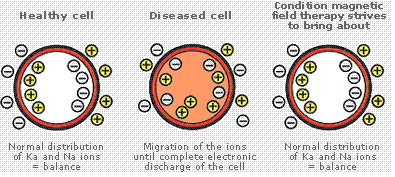
Increased
Oxygen Supply
- In aerobic cell respiration (increased stamina in athletic performance)
- In anaerobic cell respiration (more rapid regeneration as a result
of expulsion of lactates and faster incorporation of glycogens into muscle
cells)
- General increase in metabolism owing to increase in combustion processes
within the cells (mitochondria)
Improved
Circulation
- Circulatory problems: in vascular disease caused by diabetes and sclerosis
(arteriosclerosis), in varicose veins with ulcers
- Accelerated absorption of bruises (haematomas)
- Expulsion of lymph oedema
Magnetic fields have been found to significantly
affect cardiac function, in addition to effects on a
myriad of other body systems and problems. Not all magnetic
fields are the same. Different types of magnetic fields
may have different effects on the heart.
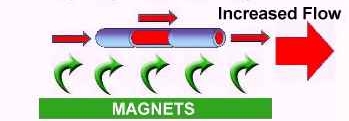
Doctors have presented papers at the North
American Academy of Magnetic Therapy, citing success
with magnets in patients with congestive heart failure
and various types of cancerous conditions.
"Some
of the effects of magnets on circulatory function
are greater blood vessel dilation and increased oxygenation
of tissues. Biomagnetic therapy may
also improve vascular resistance and decrease the
stickiness of blood platelets. People with a peripheral
vascular disorder and arteriosclerosis may therefore
benefit from magnetic therapy. Biomagnetic therapy
may also undo blockages throughout the body, such
as in the vessels of the lower extremities, the arteries
in the neck, and the blood vessels in the hands and
arms. By opening up a blockage in the heart, magnets
may help prevent or improve ischemic heart disease,
angina, and heart attacks."
"There is also much
evidence of accelerated tissue healing effects
where there has already been tissue damage, either
from ischemia or mechanical or surgical trauma.
Tissue healing with PEMFs appears to be accelerated
by about one third to one half the usual time
and results in fewer tissue complications, such
as infections and poor or aggressive scar formation.
In addition to stress protein effects mentioned
above, but also free radical scavenging and accelerating
RNA/DNA production in laying down new repair
tissue. This means that, if cardiac surgery is
required, not only would EMFs help tissues to
be less traumatized but also would help speed
recovery afterwards. " William Pawluk,
MD, MSc More info
|
"Hypertensive patients are affected positively,
depending on the function of the heart before magnetic
treatment. People with normal functioning hearts just
have their vascular resistance lowered. EMFs normalize
heart function and circulation in patients with high
BP, and at the same improve circulation. The improvements
in systemic vascular tone, as well as lipid metabolism
and coronary circulation make MFs very useful treatment
for people with the combination of hypertension and ischemic
heart disease."
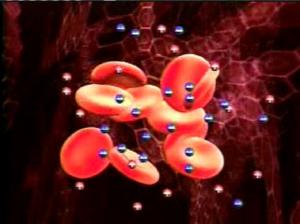
|
There is significant precedent
in the literature for the results reported above.
Kepler et al. (1990) reported the effects of
the neurons with oscillatory properties on the
composite of neural networks. This work illustrates
the likelihood that a pulse width modulated system
might bring on specific responses in neural tissues.
As previously discussed, Valentini et al. (1993)
demonstrated the ability to enhance the outgrowth
of neural fibers on materials that possess a
weak electric charge. This would indicate that
intense electric fields are not necessarily an
essential component of this process, and that
a weak and persistent stimulus might yield a
measurable effect.
|

Magnetolaser therapy (MLT) has been studied
in single placebo control trial in the treatment of ischemic
heart disease patients, with exertional angina and moderately
to severely impaired function, post-myocardial infarction.
Most had significantly decreased circulation. MLT was
applied to 3 tender zones on the chest: in the front
over the upper part of the heart and middle of the sternum,
and in back between the scapulas to the left of the mid
line, for 12 min, 4 min for each exposure zone, daily
over 15 days. Work capacity increased in 84% of the MLT
group but worsened in the placebo group. The work increased
most for patients with functional classes II and III
angina. MLT was also useful for patients with conduction
disorders, eliminating extra beats in 29% and decreasing
them by more than 70% in 32% of cases and stopping paroxysmal
atrial fibrillation in 53%. The treatment lasted through
the follow-up period of 12 to 16 months. These impressive
results show that MLT facilitates adaptation to a physical
load, and promotes rearrangement of central hemodynamics
and recovery and stabilization of electrical activity
of heart cells, safely and simply.
|
Additional evidence of the
effects of magnetic fields exists in the work
of Sandyk et al. (1992a). This communication
details dramatic improvement of a patient with
progressive degenerative multiple sclerosis.
Briefly, the patient showed considerable improvement
when subjected to treatment at a frequency of
2-7 Hz and an intensity of the magnetic field
of 7.5 pico Tesla. These parameters marginally
parallel those of this report. In a similar fashion,
Sandyk et al. (1992b)
reported significant improvement in patents treated with the same
field strength and intensity.
|
Research indicates that in general, magnetic
therapy works because of the electromagnetic nature of
the body. Every cell in our body consists of electrically
charged particles that are either positive or negative
ions. All are directly affected by exposure to external
magnetic fields.;
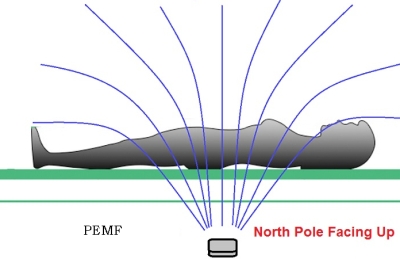
PULSED ELECTRO MAGNET FIELDS (PEMF) can
affect the body at both microscopic and at overall levels.
If the PEMF can be placed to influence a section of blood
vessel carrying the fluid flow, then the flow at that
place will be improved locally and there will be an improvement
in the alignment of the molecules,
Neuro-cardiologists have
discovered that the heart has an intrinsic nervous
system which can operate independently from the
brain. The neurons in the heart have been shown
to have both short and long-term memory. Until
recently it was believed only the brain was capable
of these functions. They now know the heart has
a powerful electromagnetic field and its complex
nervous system and circuitry generate up to an
estimated 60 times the electrical amplitude of
the brain. The electromagnetic signal our heart
rhythms produce can actually be measured in the
brain waves of people around us. We also know
our heart-rhythm patterns say a lot about our
emotional balance and the stress we are experiencing:
the calmer we are, the smoother our heart-rhythm
patterns are, while the more stress we feel,
the more chaotic the patterns are Source
|
PEMF and NASA Research
The technology has been studied by NASA in a four-year, $3.5 million
study, with most important positive results.
This four year study used human donors "to define the most effectiveelectromagnetic
fields for enhancing growth and repair in mammaliantissues." To
utilize "nerve tissue which has been refractory to efforts to stimulategrowth
or enhance its repair regardless of the energy used." (all othertissues
have demonstrated growth and repair stimulation with appropriate PEMF)
To define a PEMF technology that would "duplicate mature, threedimensional
morphology between neuronal cells and feeder (glial) cells, whichhas
not been previously accomplished." NASA'sCONCLUSION: "The up-regulation
of these genes is in no manner marginal (1.7-8.4 logs)with gene sites
for collagen production and growth the most actively stimulated." "We
have clearly demonstrated the bioelectric/biochemical potentiation of
nerve stimulation and restoration in humans as a documented reality".

|
" Results of this study
involving 23 parasystolic children found that
low-frequency magnetic field exposure improved
humoral and cellular processes involved in the
regulation of cardiac rhythm.58
Results indicated positive effects on peripheral capillaries in
75-82 percent of patients receiving the treatment at a pre-gangrene
stage.59
Results of this study showed exposure to low-frequency alternating
magnetic fields had beneficial effects in children with primary
arterial hypertension, as seen in the attenuation of sympathetic
and vagotonic symptoms.6"
|
"The
most effective electromagnetic field for repair of
trauma was squarewave with a rapid rate of change
(dB/dt) which saw cell growth increased up to4.0
times." They
further noted that "slowly varying (millisecond
pulse, sine wave) ornon varying DC (CW lasers, magnets)
had little to no effect."

Final Recommendation: "One
may use square wave EM fields with rapid rateof change
for": • repairing traumatized tissues • moderating
some neurodegenerative diseases • developing
tissues for transplantation I have thought for a
long time that electromagnetic energy is a form of
human life force - just as it is for the universe.
|
The present investigation details the development
of model systems for growing two- and threedimensional
human neural progenitor cells within a culture
medium facilitated by a time-varying electromagnetic
field (TVEMF). The cells and culture medium are
contained within a two- or three-dimensional
culture vessel, and the electromagnetic field
is emitted from an electrode or coil. These studies
further provide methods to promote neural tissue
regeneration by means of culturing the neural
cells in either configuration. Grown in two dimensions,
neuronal cells extended longitudinally, forming
tissue strands extending axially along and within
electrodes comprising electrically conductive
channels or guides through which a time-varying
electrical current was conducted. In the three-dimensional
aspect, exposure to TVEMF resulted in the development
of three-dimensional aggregates, which emulated
organized neural tissues. In both experimental
configurations, the proliferation rate of the
TVEMF cells was 2.5 to 4.0 times the rate of
the non-waveform cells. Each of the experimental
embodiments resulted in similar molecular genetic
changes regarding the growth potential of the
tissues as measured by gene chip analyses, which measured more than 10,000 human genes simultaneously.
A waveform (TVEMF) generator of original
design and capability was developed and used
to generate the waveform in a strength of 1-6
mA (AC) square
wave, 10 Hz variable duty cycle, which
was pulse-width modulated (Goodwin et al. patent
cases MSC 22633-1; US Patent, 6,485,963, B1
and MSC 22633-2 Notice to Issue). NHNP cells
were subjected to these extremely low-level
magnetic fields (ELF waves) (~10 – 200
mGauss), which are far less than
the field strength of the Earth. .More
Nasa research
|
At the University of Giessen scientists
successfully proved that even magnetic fields of the
lowest intensity (in the picotesla range) have an undeniable
effect on the well-being of humans. Similarly, the natural
phenomenon of weather systems is an example of the effects
of even low intensity magnetic fields
10HZ
"In 1989 David Hood found chronic
(30+ days) 10 Hz stimulation TRIPLED
two CRITICAL enzymes used during final stages of cell
respiration. Citrate-synthase the regulator of the Krebs
cycle and cytochrome-c-oxidase. which is critical in
the electron transport chain. Hood concluded this was
due to similarly increased mitochondrial ribonucleic
acid (mtRNA).
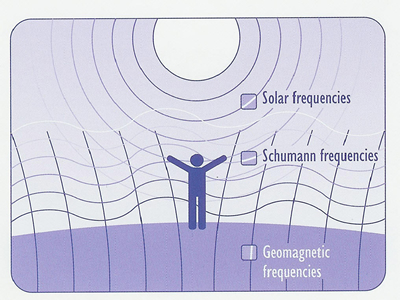
Magnetic fields can penetrate
most solid objects
|
Alzheimer’s Disease
On review, after applying external electromagnetic fields ranging
5 to 8 Hz, large improvements were detected in Alzheimer’s
patients. These included improved visual memory, drawing
performance, spatial orientation, mood, short-term memory
and social interactions.
R. Sandyk, “Alzheimer’s
Disease: Improvement of Visual Memory and
Visuoconstructive Performance Treatment with
Picotesla Range Magnetic Fields,” International
Journal of Neurosci, 76(3-4),
June 1994, p. 185-225.
|
In 2003 NASA-Goodwin found
10 Hz square wave stimulation caused
neural tissue regeneration @ 4x baseline, w/ better
3-D orientation; cell DNA signature turned - OFF
- 120+ sets of maturation genes and turned - ON -
120+ sets of developmental genes. Over 100 sets of
nucleic DNA reverted from maturation to developmental.
NASA didn't dig deep enough to explain why cell
regeneration QUADRUPLED under 10 Hz pulsed electromagnetic
field (PEMF) or why the genetic effects
occurred ONLY at 10 Hz pulsed electromagnetic field
(PEMF). However moreATP explains very well based
upon the work of David Hood and the efficient demonstration
by James Tong below.

There are 40,000 sensory neurons
relaying information to the brain from the heart leading
researchers to call the heart the "little brain" and
to coin the field as neurocardiology.
In 2007 James Tong DOUBLED mitochondrial density at
the nerve synapse but TRIPLED
nerve synapse energy utilizing 10 Hz stimulation.
These synergistic changes took only 5 minutes to manifest.
It is prudent to consider Tong fist stimulated at 1/2
Hz for just two minutes and both mitochondrial density
and nerve junction energy parameters fell by 20%. However
within 5 minutes at 10
Hz both measurements soared. Compare
mitochondrial DENSITY of unstimulated mitochondria (white
circles) w/ 10 Hz stimulated mitochondria (black circles);
compare TOTAL ENERGY at synapse junction unstimulated
(white circles) w/ 10 Hz stimulated (black circles).
Mitochondrial density change = 2x+ and Synapse Energy
change = 3x+ so each mitochondria increased its energy
production by 50% within 5 minutes"
|
As a matter of interest,,In
1963, Baule and McFee were able to measure the
magnetic field produced by the electrical activity
of the heart muscle. This strong pulsating magnetic
field spreads out in front of and behind the
body, and instruments are now available that
can detect the field of the heart 15 feet away
from the body. (Oschman, 29-30)
|
Having healthy cells is not a passive process.
Active, regular tuning-up of our cells is not only feasible,
but
also necessary to slow aging and reduce the risk
of cell dysfunction. We are, after all, only as healthy
as our cells. Imperceptible cell dysfunction that is
not corrected early can lead to disease. Fine-tuning
can be done daily in only minutes, using pulsed electromagnetic
fields (PEMFs). In addition, when there is a known imbalance
(when symptoms are present) or there is a known disease
or condition, PEMF treatments, used either alone or along
with other therapies, can often help cells rebalance
dysfunction faster.
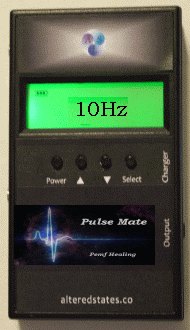 |
Pulse-Mate
PEMF Pulsed Electro Magnetic
Fields
Frequencies
 0.5
,,Stress,,Anxiety,,Fast Relaxation,,Sleep,
BP, hypertension 0.5
,,Stress,,Anxiety,,Fast Relaxation,,Sleep,
BP, hypertension
 .952-1.00
Hz Deep Restfull Sleep , Rejuvination, vessel
obliteration diseases,atrial fibrillation
reserch .952-1.00
Hz Deep Restfull Sleep , Rejuvination, vessel
obliteration diseases,atrial fibrillation
reserch
 5.00
Hz 5Hz -Increased DNA synthesis; cellular
signalling; repair and
healing 5.00
Hz 5Hz -Increased DNA synthesis; cellular
signalling; repair and
healing
 7.83
Hz Alpha / Theta, "Schumann
Resonance, Deep Meditation": 7.83
Hz Alpha / Theta, "Schumann
Resonance, Deep Meditation":
 10Hz
Cell Rejuvination, mitochondrial density, 10Hz
Cell Rejuvination, mitochondrial density,
 100
Hz Depression fatigue:
lack of energy, 100
Hz Depression fatigue:
lack of energy,
 Pulsemate
unit Pulsemate
unit
 Pulsemate
Coil and Lead Pulsemate
Coil and Lead
 Pulsemate
Coil Driver Pulsemate
Coil Driver
 High
Quality Ear Clips High
Quality Ear Clips
 Rechargable
Batteries Rechargable
Batteries
 Charger(multi
voltage (120v-240v) Charger(multi
voltage (120v-240v)
 Instructions Instructions
|
If you have one of our rife machine option 2h-7h
you will not need the pulsemate as your unitl is
able to acces the desired frequencies and can be
used with the magnacoil, for pemf
| |
PEMF Therapy and Atrial Fibrillation
"PEMF
is the most effective when it is used in the
initial stages of atrial fibrillation. One of
the major factors for this condition
is inflammation in the body. PEMF has been
shown useful in treating inflammation and can
help people with AFib. (1)
PEMF therapy is not necessarily used by itself
during the later stages but may be effective
with other conventional therapies. In this
instance, PEMF can heighten the impact of the
other therapies
while decreasing any
side effects.
PEMF’s work by sending the cells in
the body electromagnetic waves.The sinus code
can be affected by sending PEMF stimulation
towards the atria and the
chest.
This determines the heartbeat’s pace.Frequencies
below 2000 Hz are generally considered the
most effective on achieving the desired
results.There are sources suggesting highly positive
results can be achieved with a frequency of
ten Hz and under.
Dr. Pawluk believes has done a lot of research
regarding PEMF’s.
He believes very good results can be achieved
with fifteen to thirty minutes of timulation
to the chest.
This reduces the symptoms.
A study on dogs was recently conducted to
provide additional insight as to the way PEMF
can suppress atrial fibrillation. Helmholtz coils
were powered using a function generator. This
created a 0.952 Hz, 0.034 uG electromagnetic
field. More
here "
Using Low-Level Electromagnetic Fields to Treat
Atrial Fibrillation
|
 |
PEMF Pulser
 High power very low frequency PEMF 0-1 hz
(0-72 BPM) High power very low frequency PEMF 0-1 hz
(0-72 BPM)
 Totally
Solid State Design, Totally
Solid State Design,
 Variable speed from 1 pulse to 75 pulses a
minute. . Variable speed from 1 pulse to 75 pulses a
minute. .
 Bob Beck type magnetic pulser 6500-7000 gauss
at 7 pulses per min Bob Beck type magnetic pulser 6500-7000 gauss
at 7 pulses per min
 1-30 min Timer 1-30 min Timer
 Double
the penetratioin of the other pulsers Double
the penetratioin of the other pulsers
 You can hear the magnetic pulser pulse You can hear the magnetic pulser pulse
 Doesn't over heat after a short time Doesn't over heat after a short time
 More information here More information here
|
iPods placed within 2 inches of implanted
pacemakers monitored via the telemetry wand
can cause interference with pacemakers source
Not to be used with pacemakers
Heart Disease
Some interesting facts
Results of this study
found that the addition of magnetotherapy to the
treatment of patients suffering from ischemic heart
disease and osteochondrosis led to clinical improvements.
I. Rodin, et al., “Use of Low-Intensity Eddy Magnetic
Field in the Treatment of Patients with Skin Lymphomas,” Voen
Med Zh, 317(12), 1996, . 32-34.
Results of this study
involving 23 parasystolic children found that low-frequency
magnetic field exposure improved humoral and cellular
processes involved in the regulation of cardiac rhythm.
M.A. Dudchenko, et al., “The Effect of Combined
Treatment with the Use of Magnetotherapy on the Systemic
Hemodynamics of Patients with Ischemic Heart Disease
and Spinal Osteochondrosis,”Lik Sprava, (5), May
1992, . 40-43.
Results of this study
showed exposure to low-frequency alternating magnetic
fields had beneficial effects in children with primary
arterial hypertension, as seen in the attenuation
of sympathetic and vagotonic symptoms.
Y.B. Kirillov, et al., “Magnetotherapy
in Obliterating Vascular Diseases of the Lower Extremities,” Vopr
Kurortol Fizioter Lech Fiz Kult, (3), May-June 1992,
. 14-17.
This study demonstrated
that traveling pulsed magnetic field and magnetic
laser treatment produced beneficial effects in patients
suffering from the initial stages of essential hypertension.
V.S. Zadionchenko, et al., “Prognostic
Criteria of the Efficacy of Magnetic and Magnetic-laser
Therapy in Patients with the Initial Stages of Hypertension,” Vopr
Kurortol Fizioter Lech Fiz Kult, (1),January-February
1997, . 8-11.
In this article, the authors
propose a new approach to treating atherosclerosis
through the alteration of biophysical properties
both intracellularly and extracellularly. Citing
their own preliminary data, they suggest atherosclerotic
lesions might be selectively resolved without harming
normal blood vessels
allowing the lesions to
take up the magnetically excitable submicron particles
and then applying an external alternating electromagnetic
field.
R.T. Gordon & D.
Gordon, “Selective Resolution of Plaques and
Treatment of Atherosclerosis Biophysical Alteration
of “Cellular” and “Intracellular” Properties,” Medical
Hypotheses, 7(2), February 1981, . 217-229.
This study examined the
effects of constant MKM2-1 magnets on essential hypertension
patients. Results indicated the treatment decreased
arterial pressure in stage II patients, with magnetotherapy
being shown to produce beneficial effects on the
central hemodynamics and microcirculation.
S.G. Ivanov, et al., “The Magnetotherapy
of Hypertension Patients,” Ter Arkh, 62(9),
Results from several recent
studies conducted the author are reviewed. Conclusions
are that pulsed electromagnetic fields exhibit protective
effects against necrosis from acute ischemia in rats,
cerebral infarcts in rabbits, and myocardium infarcts
in rats.
R. Cadossi, “Protective Effect
of Electromagnetic Field Exposure on Acute Soft Tissue
Ischaemic Injury,” Second World Congress for
Electricity and Magnetism in Biology and Medicine,
8-13 June 1997, Bologna, Italy.
This study examined
the effects high frequency electromagnetic radiation
(EHF EMR) in 93 patients suffering ischemic heart
disease. EHF treatment consisted of 10 to 15 exposures
of the lower end of the sternum from a ‘Yav’-1-7,1
device. Treatment was performed five times weekly
for a total of 30 minutes per day, with drug therapy
being maintained during this period. Positive results
tended to occur after 5 to 6 treatment sessions,
with a good or satisfactory response being reported
in 82 of 93 patients, and lasting as long as 11 months
after hospital release.
I.E. Ganelina, et al., “Electromagnetic
Radiation of Extremely High Frequencies in Complex
Therapy for Severe Stenocardia,” Millimetrovie
Volni v Biologii I Meditcine, (4), 1994, . 17-21.
In this study,
30 myocardial infarction patients received millimeter-wave
(MW) therapy in the form of 10 exposures of 30 minutes
per day, with a 2-day interruption after the fifth
exposure. Patients continued conventional drug treatment
during the MW therapy period. Better results were
seen in those patients exposed to the MW therapy
relative to an equal number of patients receiving
conventional treatment only.
N.N. Naumcheva, “Effect of Millimeter
Waves on Ischemic Heart Disease Patients,” Millimetrovie
Volni v Biologii I Meditcine, (3), 1994, . 62-67.
Results of this placebo-controlled
study demonstrated a 76-percent effectiveness rate
for running impulse magnetic field therapy in a group
of arterial hypertensive patients. Treatment consisted
of two 25-minute exposures per day over a period
of 10-20 total exposures, at frequencies of 10 or
100 Hz and magnetic field intensity of 3 or 10 mT.
L.L.Orlov, et al., ” Indications
for Using a New Magnetotherapeutic Method in Arterial
Hypertension,” Soviet Medicine, (8), 1991, .
23-24.
This study examined
the efficacy of the reinfusion of autologous blood
following magnetic field exposure in hypertensive
patients. Positive effects were found in 92 percent
of patients receiving the treatment.
I.G. Alizade, et al., “Magnetic
Treatment of Autologous Blood in the Combined Therapy
of Hypertensive Patients,” Vopr Kurortol Fizioter
Lech Fiz Kult, (1), 1994, . 32-33
This double-blind,
placebo-controlled study examined the effects of
magnetotherapy in patients suffering from first-or
second-stage hypertension. A magnetic field of 50
Hz, 15-25 mT was applied to acupuncture points He-Gu
and Shen’-Men for 15-20 seconds per day for
a total of 9-10 days. Results: The treatment improved
headaches in 88 percent of patients, dizziness in
89 percent, and irritability in 88 percent. In general,
95 percent of hypertensive patients experienced beneficial
effects from the treatment, and the morbidity rate
decreased twofold following one course extended over
a period of 5-6 months.
E.V. Rolovlev, “Treatment of Essential
Hypertension Patients an Alternating Magnetic Field
Puncture,” All-Union Symposium: Laser and Magnetic
Therapy in Experimental and Clinical Studies, June
16-18, 1993, Obninsk, Kaluga Region, Russia, . 221-223.
This study examined the
effects of low-frequency alternating magnetic fields
in patients suffering from arteriosclerosis or osteoarthrosis
deformans. Treatment involved 10-15 minute daily
leg exposures over a total of 15 days. Results showed
the treatment to be effective in 80 percent of arteriosclerosis
patients and 70 percent of those with osteoarthrosis
formans.
A.G. Kakulia, “The Use of Sonic
Band Magnetic Fields in Various Diseases,” Vopr
Kurortol Fizioter Lech Fiz Kult, 3,1982, . 18-21.
This study examined the
effects of low-frequency magnetic fields (25 mT)
in patients suffering atherosclerotic encephalopathy.
Treatment involved 10-15 minute daily exposures over
a total of 10-15 applications. Results showed clinical
improvements with respect to chest pain, vertigo,
headache, and other symptoms.
S.S. Gabrielian, et al., “Use of
Low-Frequency Magnetic Fields in the Treatment of Patients
with Atherosclerotic Encephalopathy,” Vopr Kurortol
Fizioter Lech Fiz Kult, 3, 1987, . 36-39.
Chronic Venous Insufficiency
This study examined the
effects of alternating magnetic fields (15-20 minutes
per day over a period of 20 days) in patients suffering
from chronic venous insufficiency, varicose veins,
and trophic shin ulcers. Results showed good effects
in 236 of the 271 patients receiving the treatment.
Thirty-four patients reported satisfactory effects.
Only one patient experienced no effects.
E.I. Pasynkov, et al., “Therapeutic
Use of Alternating Magnetic Field in the Treatment
of Patients with Chronic Diseases of the Veins of the
Lower Limbs,” Vopr Kurortol Fizioter Lech Fiz
Kult, 5,1976, . 16-19.
This review article notes
that magnetotherapy in a variety of forms has been
successfully used in the treatment of chronic venous
insufficiency and is a commonly used physical therapy
for the condition.
A.P. Dovganiuk, “Balneologic
and Physical Therapy of Chronic Venous
Insufficiency of Extremities,” Vopr Kurortol Fizioter
Lech Fiz Kult, 2, 1995, . 48- 49.
This study examined the
effects of magnetic fields in patients suffering
from vessel obliteration diseases of the legs. Treatment
consisted of 15- 20 whole body exposures (0.5-5 mT,
1-2 Hz) lasting 15-20 minutes each. Results showed
treatment led to a significant reduction in the number
of patients experiencing leg pain while at rest.
Among patients previously unable to walk a 500-m
distance, 52 percent were able to complete the distance
following treatment. Circulation improved in 75-82
percent of patients.
Y.B. Kirillov, et al., “Magnetotherapy
for Obliterative Disease of the Vessels of the Legs,” Vopr
Kurortol Fizioter Lech Fiz Kult, 3, 1992, .. 14-17.
"Early in the course of use of MFs in patients,
there are changes in ECGs to a lower wave size pattern,
sinus rhythm and extra beats, and a decrease in heart
rate. With continuing magnetotherapy, these changes disappear
and cardiovascular function is improved. This is common
with MF therapy. Meanwhile, there may be temporary worsening
while repair and rebalancing is happening, with the outcome
being more normal function and health."
sources
http://www.sld.cu
57. M.A. Dudchenko, et al., "The Effect
of Combined Treatment with the Use of
Magnetotherapy on the Systemic Hemodynamics of Patients with Ischemic
Heart
Disease and Spinal Osteochondrosis," Lik Sprava, (5), May 1992,
p. 40-43.
58. E.M. Vasil'eva, et al., "The Effect of a Low-frequency Magnetic
Field on
Erythrocyte Membrane Function and on the Prostanoid Level in the Blood
Plasma of
Children with Parasystolic Arrhythmia," Vopr Kurortol Fizioter Lech
Fiz Kult, (2),
March-April 1994, p. 18-20.
59. Y.B. Kirillov, et al., "Magnetotherapy in Obliterating Vascular
Diseases of the
Lower Extremities," Vopr Kurortol Fizioter Lech Fiz Kult, (3), May-June
1992, p. 14-
17.
60. O.M. Konova & M.A. Khan, "The Effect of a Low-frequency
Alternating Magnetic
Field on the Autonomic Nervous System in Children with Primary Arterial
Hypertension," Vopr Kurortol Fizioter Lech Fiz Kult, (2), March-April,
1996, p. 8-10.
61. V.S. Zadionchenko, et al., "Prognostic Criteria of the Efficacy
of Magnetic and
Magnetic-laser Therapy in Patients with the Initial Stages of Hypertension," Vopr
Kurortol Fizioter Lech Fiz Kult, (1), January-February 1997, p. 8-11.
62. R.T. Gordon & D. Gordon, "Selective Resolution of Plaques
and Treatment of
Atherosclerosis Biophysical Alteration of "Cellular" and "Intracellular" Properties,"
Medical Hypotheses, 7(2), February 1981, p. 217-229.
63. S.G. Ivanov, et al., "The Magnetotherapy of Hypertension Patients," Ter
Arkh,
62(9), 1990, p. 71-74.
|

